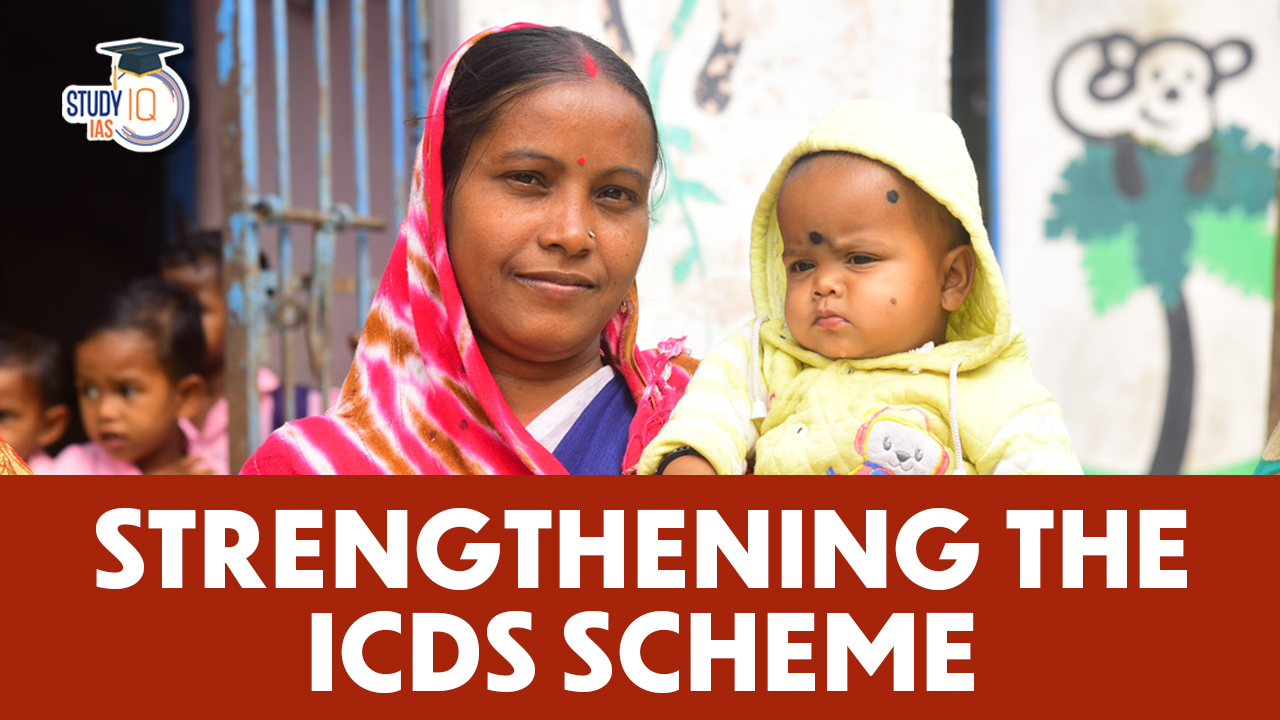Table of Contents
Context: India must strengthen its existing social sector schemes, such as the Integrated Child Development Services (ICDS), to effectively address the persistent public health risks of high prevalence of stunting, wasting, and anaemia among children and women.
About the Integrated Child Development scheme (ICDS)
| About | The Umbrella ICDS is a centrally sponsored scheme implemented by the Ministry of Women and Child Development. It was launched in 1975. |
| Objectives |
|
| Services under ICDS | The primary goal of ICDS is to break the inter-generational cycle of malnutrition by providing the following six services as a package through the network of Anganwadis:
|
| Schemes under ICDS | 1) Anganwadi Services Scheme:
2) Pradhan Mantri Matru Vandana Yojana:
3) National Creche Scheme:
4) Scheme for Adolescent Girls:
5) Child Protection Scheme:
6) POSHAN Abhiyaan:
|
Significance of ICDS
- A study published in World Development demonstrated the ICDS’s positive impact on cognitive achievements, especially among girls and those from economically disadvantaged families.
- Another peer-reviewed study in The University of Chicago Press Journals found that children who were exposed to ICDS during the first three years of life completed 0.1-0.3 more grades of schooling than those who were not.
- In a study published in the Natural Library of Medicine, it was found that adolescents aged 13-18, who born in villages with proper ICDS implementation, showed a 7.8% increased likelihood of school enrolment and completed an average of 0.8 additional grades compared to their peers who did not have access to the ICDS.
Current status of child malnutrition in India
- As per the recent report of NFHS-5 (2019-21), the nutrition indicators for children under 5 years have improved as compared with NFHS-4 (2015-16).
- Stunting has reduced from 38.4% to 35.5%, Wasting has reduced from 21.0% to 19.3% and Underweight prevalence has reduced from 35.8% to 32.1%.
Various problems in the implementation of ICDS
- Quality of Services: There are concerns about the quality of services provided through ICDS. This includes issues such as inadequate infrastructure, lack of trained and motivated personnel, and insufficient availability of essential supplies and equipment.
- Inadequate Enrolment: Lack of awareness among the target group have resulted in children and expectant/nursing mothers being left out from the services, especially in rural areas.
- Supplementary Nutrition: There have been instances of “nutrition-interruption,” where beneficiaries were not provided with supplementary nutrition for the recommended 300 days a year.
- Lack of Coordination: There is a lack of coordination between the health and women and child welfare departments, which hampers the effectiveness of programs like immunization.
- Monitoring and Evaluation: ICDS faces challenges in terms of proper monitoring and evaluation, including inadequate data collection, limited capacity for data analysis, and a lack of timely feedback and corrective measures.
- Limited Community Participation: There are often barriers to meaningful community participation, including low awareness, limited engagement of community members in program planning and decision-making, and a lack of mechanisms to solicit feedback and address concerns.
- Urban-Rural Disparity: ICDS implementation faces specific challenges in urban areas, where population density, migration, and a lack of adequate infrastructure pose hurdles in reaching and delivering services to vulnerable populations.
The role of Anganwadi workers in ICDS
- Anganwadi workers are the cornerstone of ICDS implementation.
- These workers bear the onus of advancing child nutrition, health, and education in their communities.
- Their roles vary widely from employing modern technology, like smartphones and applications, to practical tasks such as delivering health education, managing feeding programmes, and liaising with auxiliary nurse midwives and other healthcare professionals.
Empowering Anganwadi workers to strengthen ICDS implementation
- Though the Anganwadi workers are cornerstone of the ICDS, they are frequently stretched beyond their limits. Hence, a significant first step towards fortifying the programme is to empower Anganwadi workers.
- Advantages of increasing the Anganwadi workforce: An additional Anganwadi worker could be added to each of India’s 13,99,661 Anganwadi centers to lessen the load of these workers. Implementing this approach could yield the following advantages:
- Improved Health and Educational Outcomes: Studies have shown that additional staff in ICDS centers results in better educational outcomes for enrolled children. It also contributes to reduced rates of child stunting and severe malnutrition.
- Cost-Effectiveness: The cost of implementing this model nationwide is relatively insignificant compared to the potential benefits. The long-term benefits, considering improvements in lifetime earnings, far outweigh the expenses, estimated to be around 13 to 21 times the investment.
- Specialization and Efficiency: With an additional worker, the workload can be divided more efficiently. The new worker can focus specifically on preschool and early childhood education, allowing existing workers to dedicate more time and attention to child health and nutrition.
- Job Creation and Women Empowerment: The addition of 1.3 million new jobs across India provides economic empowerment to women in rural communities, contributing to their overall well-being and socio-economic development.
Other measures to strengthen ICDS implementation
- Capacity Building: Provide training to enhance knowledge and skills of Anganwadi workers in child development, health, and program management.
- Quality Infrastructure and Resources: Improve centers with better facilities, materials, and supplies.
- Strengthen Monitoring and Evaluation: Establish effective systems for tracking and improving program implementation.
- Community Participation and Awareness: Engage communities and raise awareness on child development and nutrition.
- Convergence and Coordination: Improve coordination among departments and programs for better outcomes.
- Technology and Innovation: Utilize digital tools and innovation for efficient program management.


 UPPSC Previous Year Question Papers, Dow...
UPPSC Previous Year Question Papers, Dow...
 Most Commonly Used Cancer Drugs and Thei...
Most Commonly Used Cancer Drugs and Thei...
 Tansen Biography, Musical Legacy and Mas...
Tansen Biography, Musical Legacy and Mas...





















